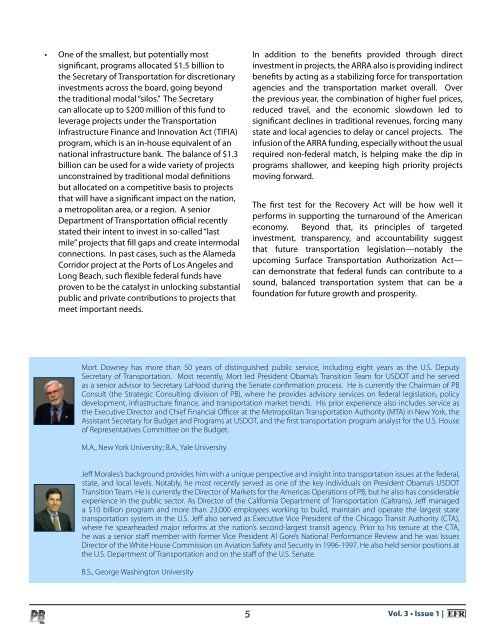Volume 3 Issue 1.indd - Parsons Brinckerhoff
Volume 3 Issue 1.indd - Parsons Brinckerhoff
Volume 3 Issue 1.indd - Parsons Brinckerhoff
Create successful ePaper yourself
Turn your PDF publications into a flip-book with our unique Google optimized e-Paper software.
• One of the smallest, but potentially most<br />
significant, programs allocated $1.5 billion to<br />
the Secretary of Transportation for discretionary<br />
investments across the board, going beyond<br />
the traditional modal “silos.” The Secretary<br />
can allocate up to $200 million of this fund to<br />
leverage projects under the Transportation<br />
Infrastructure Finance and Innovation Act (TIFIA)<br />
program, which is an in-house equivalent of an<br />
national infrastructure bank. The balance of $1.3<br />
billion can be used for a wide variety of projects<br />
unconstrained by traditional modal definitions<br />
but allocated on a competitive basis to projects<br />
that will have a significant impact on the nation,<br />
a metropolitan area, or a region. A senior<br />
Department of Transportation official recently<br />
stated their intent to invest in so-called “last<br />
mile” projects that fill gaps and create intermodal<br />
connections. In past cases, such as the Alameda<br />
Corridor project at the Ports of Los Angeles and<br />
Long Beach, such flexible federal funds have<br />
proven to be the catalyst in unlocking substantial<br />
public and private contributions to projects that<br />
meet important needs.<br />
In addition to the benefits provided through direct<br />
investment in projects, the ARRA also is providing indirect<br />
benefits by acting as a stabilizing force for transportation<br />
agencies and the transportation market overall. Over<br />
the previous year, the combination of higher fuel prices,<br />
reduced travel, and the economic slowdown led to<br />
significant declines in traditional revenues, forcing many<br />
state and local agencies to delay or cancel projects. The<br />
infusion of the ARRA funding, especially without the usual<br />
required non-federal match, is helping make the dip in<br />
programs shallower, and keeping high priority projects<br />
moving forward.<br />
The first test for the Recovery Act will be how well it<br />
performs in supporting the turnaround of the American<br />
economy. Beyond that, its principles of targeted<br />
investment, transparency, and accountability suggest<br />
that future transportation legislation—notably the<br />
upcoming Surface Transportation Authorization Act—<br />
can demonstrate that federal funds can contribute to a<br />
sound, balanced transportation system that can be a<br />
foundation for future growth and prosperity.<br />
Mort Downey has more than 50 years of distinguished public service, including eight years as the U.S. Deputy<br />
Secretary of Transportation. Most recently, Mort led President Obama’s Transition Team for USDOT and he served<br />
as a senior advisor to Secretary LaHood during the Senate confirmation process. He is currently the Chairman of PB<br />
Consult (the Strategic Consulting division of PB), where he provides advisory services on federal legislation, policy<br />
development, infrastructure finance, and transportation market trends. His prior experience also includes service as<br />
the Executive Director and Chief Financial Officer at the Metropolitan Transportation Authority (MTA) in New York, the<br />
Assistant Secretary for Budget and Programs at USDOT, and the first transportation program analyst for the U.S. House<br />
of Representatives Committee on the Budget.<br />
M.A., New York University; B.A., Yale University<br />
Jeff Morales’s background provides him with a unique perspective and insight into transportation issues at the federal,<br />
state, and local levels. Notably, he most recently served as one of the key individuals on President Obama’s USDOT<br />
Transition Team. He is currently the Director of Markets for the Americas Operations of PB, but he also has considerable<br />
experience in the public sector. As Director of the California Department of Transportation (Caltrans), Jeff managed<br />
a $10 billion program and more than 23,000 employees working to build, maintain and operate the largest state<br />
transportation system in the U.S. Jeff also served as Executive Vice President of the Chicago Transit Authority (CTA),<br />
where he spearheaded major reforms at the nation’s second-largest transit agency. Prior to his tenure at the CTA,<br />
he was a senior staff member with former Vice President Al Gore’s National Performance Review and he was <strong>Issue</strong>s<br />
Director of the White House Commission on Aviation Safety and Security in 1996-1997. He also held senior positions at<br />
the U.S. Department of Transportation and on the staff of the U.S. Senate.<br />
B.S., George Washington University<br />
5 Vol. 3 • <strong>Issue</strong> 1 |

















